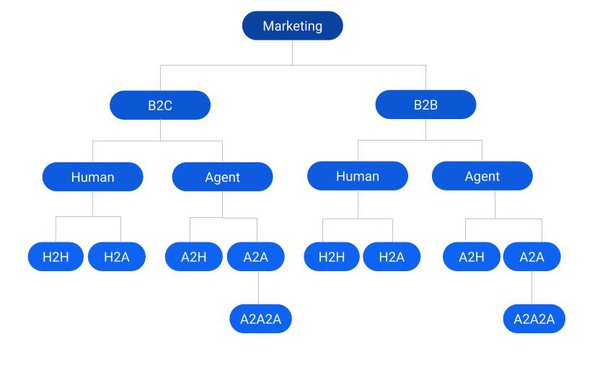
I have been thinking about agent-to-agent (A2A) marketing for nearly a
quarter of a century, even before we had acronyms to explain it.
It was at the tail end of a months-long research project between the Advertising Research Foundation and the MIT Media Lab. It
was codenamed "D-Map," and the goal was to map how digital media would impact the future of marketing.
It ended with a two-day symposium hosted by the lab during which big marketers, agencies
and media execs discussed the project's findings.
My takeaway was that in the future consumers and brands would interact via digital "filters" representing their goals and needs in a far more
symmetrical marketplace than what existed in the year 2000, much less today.
The participants used the word filters, because I don't think anyone had fully conceptualized the notion of the
kind of AI agents that have become the reality today, but the logic is the same.
advertisement
advertisement
In fact, Project VRM and the IEEE have even created a machine-readable set of standards -- MyTerms -- for consumers and brand to begin interacting that way.
Meanwhile, ad
technology developers have begun testing one-side of that equation -- agentic media-buying in which AI agents independently plan and buy ads -- aimed at humans, and have rolled out their own
standards, AdCP. And nary a day goes by that I don't get pitched for a story about
some new "AI agency" or another.
Just yesterday, I got a pitch about a new platform -- MarkeTeam.ai -- that is offering a money-back guarantee, pledging
to eat the cost of a $1,000 market trial for qualified brand campaigns for 12-week test to see if its agents can't improve the outcomes of how human teams would normally execute across paid media,
social, content and SEO campaigns.
Based on its results over the past year, the PR guy said MarkeTeam.ai has boosted "performance" by 25%, generating 12% more conversions and a 27% reduction
in the campaigns' cost-per-acquisition.
Like most ad-tech performance pitches I receive, I have not way of actually vetting them, but at least the MarkeTeam.ai agent avatars look cool.

Agentic media-buying and the
overall race to an A2A marketplace is accelerating fast, so I wanted to slow things down and think about an organizational framework for the future of advertising now that the "filters" are actually
here. Which explains the clunky org chart depicted above.
It branches the way much of modern-day marketing might, starting with categories for B2C and B2B, representing consumer and business
markets. But the 2, as you might realize always is about one side doing something to the other side. Not the kind of symmetrical relationship D-Map, or Project VRM's MyTerms likely had in mind.
That's why I threw some Hs (for humans) in there alongside the As (for agents), and at least for some time, I think it will be a collaborative process of people working with agents to get better
overall results.
If this framework has a flaw, it's that it doesn't account for the consumer's ability to re-leverage the marketing process in their favor, and honestly, I toyed with the idea
of adding a C2D -- for a consumer-to-direct counterbalance of the ad industry's D2C (direct-to-consumer orientation), but I figured that would make the org chart impossible to read, much less
follow.
If there is a conceit in the chart, it's the bottom rung "A2A2A" branching, which is a reference to the fact that the first agentic media buy I covered ironically served some ads to invalid agents, not the kind the valid
kind brands will increasingly be trying to reach.
Determining which agents are valid or invalid -- on both the consumer and the brand marketer side of the equation -- will likely be an
evolutionary process in itself, but at least one ad verification company, DoubleVerify, has stepped forward to begin measuring and filtering for it.
So we're on or way. And by our, I mean both humans and agents.
If any of you have ideas for revising this new agentic era marketing flow chart, feel free to let me know and I'll update
it.